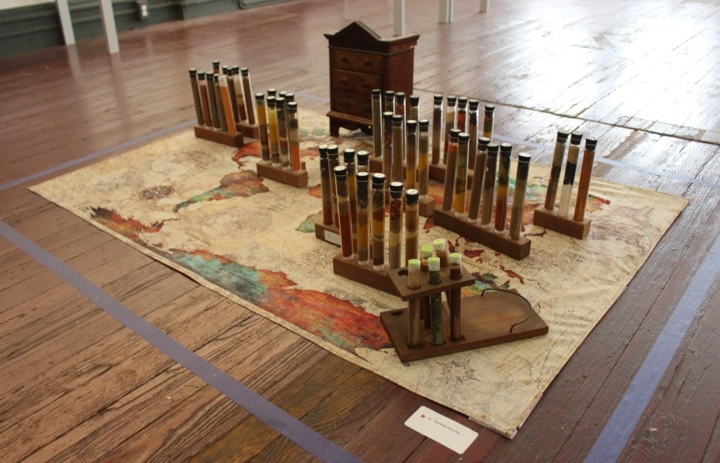
Pete Stewart
Spirit House.
The faces of the artist’s parents beam from the underside of a skillet. Wooden and metal utensils gather around it in reverence. A bottle of oil, a bottle of wine. Recipes and spices. You know it’s a shrine before you read the description of Pete Stewart’s Spirit House, but it’s not a shrine in the usual Western religious sense. It’s ancestor worship, a celebration of the deep roots of a family’s tradition, the way what we eat connects us to where we and the generations before us came from. And it is one of many such delectable pieces in “Melted Pots and Cooked Books,” the latest exhibit at the Institute Library on Chapel Street.
Curated by Martha Lewis and sponsored by the International Association of New Haven, the exhibit runs through Dec. 14.
“We are at a divisive moment with quite a lot of fearmongering designed to create anxieties and foment clannish, myopic behavior, an inward-facing selfishness that looks down on collective goods and altruism. Additionally, the current climate crisis presents very real questions about food production, and the future of what we will be eating. This set of pressures makes the social aspects of how we feed ourselves poignant and worth considering,” Lewis writes in an accompanying statement. “To be human is to share. Fairy tales, myths, ancient religious texts, folk tales all around the globe tell the same story: they warn us of the perils of not being generous and hospitable to a visitor. The old crone or ragged stranger who is welcomed to the hearth and meal is a disguised fairy or witch or savior, and the humble repast is transformed into a feast.”

“This exhibition focuses on our collective, shifting and intersecting food experiences,” Lewis continues. “Our celebrations are enactments of old traditions, blended with new innovations, contemporary preferences and often necessary modifications and modernizations…. It is my heartfelt belief that breaking bread together is interactive art in one of its most immediate and profound manifestations, and something in which we all participate.”
The works of the 30 artists in “Melted Pots” epitomize what Lewis is talking about. Robert Aiudi contributes a metal meat grinder that he inherited from his great grandfather. Above the kitchen tool is a photograph of his great grandparents, Vincenzo and Almerinda Giampalo, and their daughters Margaret and Cecelia. There’s no explanation provided and none is really necessary. The wear on the machine tells a story of heavy use, certainly by the generations above the artist. Does Robert Aiudi grind meat at home with the same device? Maybe, maybe not. But even as an heirloom, it’s a powerful reminder of where Aiudi is from and the centrality of food in keeping the family together and connected to their past, a past of people who, when they needed meat ground, did it themselves.
Other artists in the exhibit follow the same path, with moving results. Not far away is Terry Dagradi’s family pasta machine, Jan Ohye’s mortal bowl for making miso, and Clymenza Hawkins’s wooden bread bowl from the late 1800s. As the exhibit’s notes explain, it is an “heirloom object passed down from a freed slave relative.”

Along with the implements of cooking are the instructions, recipes redolent of family not only in the food they describe, but in their physical forms. Jezrie Marcano-Courtney’s stained, hand-written recipe for tostones suggests years of use. Not far away are Maria Lara-Whelpley’s recipe for and memories of making tamales de pollo. Helen Kauder contributes recipes from her parents that were also tied to her parents making music in the house; the cookbook they put together was called How to Eat Well and Play the Fiddle. Erick Cocks contributes a prize-winning chili recipe and a cookbook called Hard Time Haute Cuisine Cookbook: A Collection of Cheap, Easy and Good Recipes to Boost Your Spirits and Balance Your Budget from Louisianans Edna, Stella, and Marie Soulé, with Tina Tanen.

Rebecca Scotka
All Her Favorite Fruit.
Other artists, like Rebecca Scotka, turn fruit all the way into art, though hiding in the elaborate headdress is a nod to a regional candy superstar.

Wieslaw Jarmulowicz, meanwhile, details a darkly playful relationship to eating. One photograph, “Arabian Milk,” the artist says in an accompanying statement, “is a dream where the three greatest Arabian alchemists visited me to give me their milk. I collected the milk in my clasped hands and drank it. It should cure me.” Of what, remains a mystery. Similarly, his image of potatoes “was done after spending a few months in my cellar when the potatoes started to sprout. They reach out their translucent hands towards the light. They look like children murdered by their cruel, psychopathic mother, and try to tell their story to a casual visitor to the cellar.”

Meanwhile, Nadine Nelson’s No Passport Required — Wanderlust, Spices, Culture and the Fate of Cuisine Transcending Borders emphasizes the connections among the various traditions of the world and the ways that certain ingredients, from spices to tomatoes to onions to pasta — have traversed it.
All these voices, perspectives and recipes in the same room turn the third-floor gallery of the Institute Library into a dining room. It’s almost as if there’s a long dining table down the center of the room, and all the artists are already gathered around, sharing food, recipes, and ideas. It embodies the generous spirit that Lewis described, and we’re all invited. The only downside is that too much time spent in the room is liable to make a viewer hungry. Good thing you’re already downtown.
“Melted Pots and Cooked Books” runs at the Institute Library, 847 Chapel St., through Dec. 14. Visit the library’s website for hours and more information.